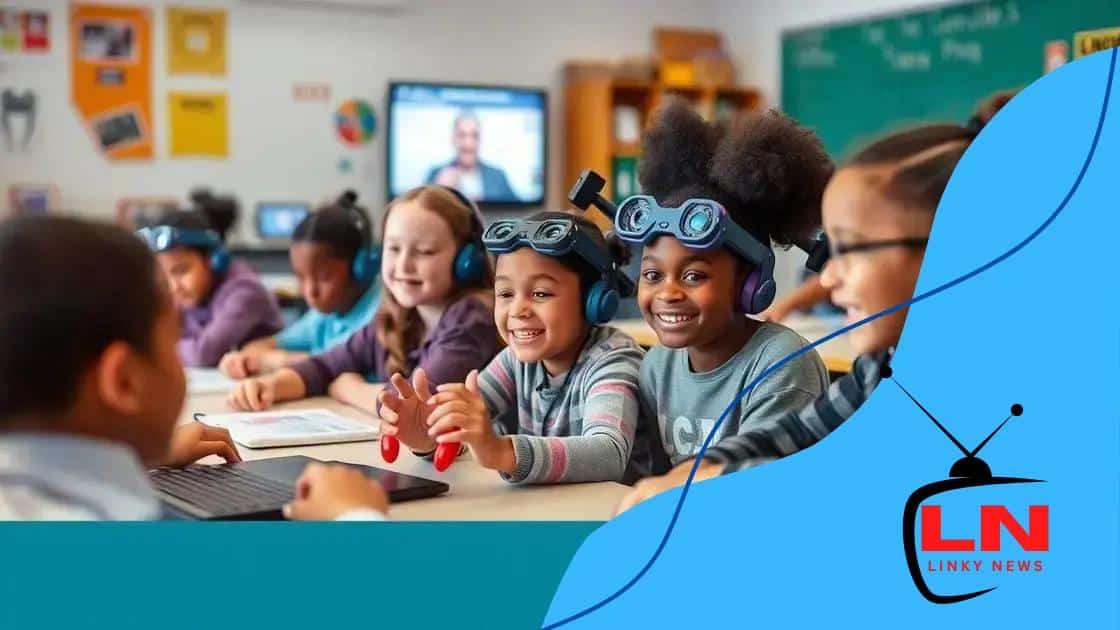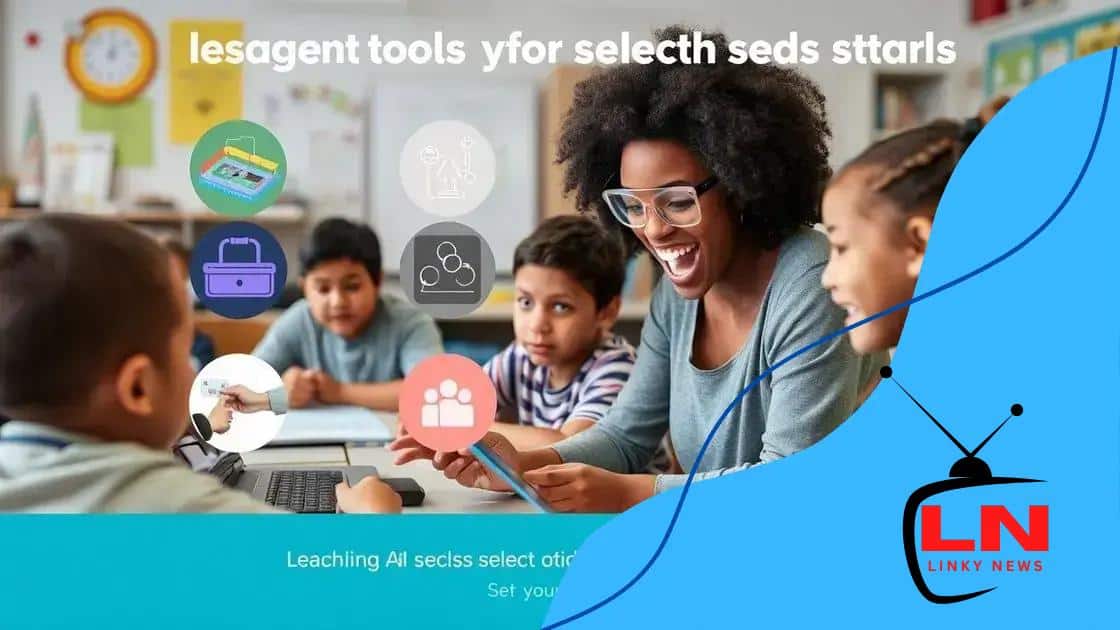AI special education tools that transform learning

AI special education tools enhance learning by providing personalized experiences, predictive analytics, and immersive technologies, ensuring students with unique needs receive effective support tailored to their individual learning styles.
AI special education tools are changing the landscape of learning, helping educators provide tailored support for students with diverse needs. Have you ever wondered how these technologies can enhance educational outcomes?
How AI is reshaping special education
Artificial Intelligence (AI) has a profound impact on how we approach special education. It is not just a trend; it is reshaping learning experiences for students with unique needs.
By integrating AI technologies, educators can create personalized learning paths that cater to the specific requirements of each student, making education more accessible.
Enhanced Learning Experiences
With the help of AI, teachers can analyze data to understand students’ strengths and areas for improvement. This approach ensures that instruction is tailored to meet individual needs. For instance, AI-driven tools can identify learning gaps and suggest proper resources that support development.
Real-time Feedback
Another significant benefit is the provision of immediate feedback. Students can engage with AI tools that correct mistakes as they learn, helping them understand concepts without delay.
- Interactive quizzes
- Instant score reports
- Adaptive learning platforms
These tools empower students to take charge of their learning. Not only does it motivate them, but it also builds confidence.
Moreover, teachers gain valuable insights into student progress through AI analytics. This data allows them to adjust teaching strategies in real-time, enhancing overall classroom dynamics.
In classrooms where AI is implemented, engagement levels skyrocket. Students become active participants rather than passive recipients of information. This shift places them at the center of their educational journey.
Collaboration Through AI
AI in special education also fosters collaboration among students. Through collaborative platforms, learners can work together on projects, using AI tools to brainstorm, share ideas, and receive feedback from peers. This collaborative spirit cultivates teamwork skills essential for future success.
Teachers can easily monitor these interactions, ensuring that all students are participating and benefiting from the group activities. The integration of AI opens up new avenues for student engagement and support.
As we look toward the future, the role of AI in special education will only continue to grow. With advancements in technology, we are likely to see even more innovative solutions that cater to diverse learning needs.
Key benefits of AI tools in classrooms
The integration of AI tools in classrooms offers a range of significant benefits. These innovations change how teachers instruct and how students learn.
AI tools provide personalized learning experiences, adjusting to individual needs and helping each student reach their full potential. This customization is essential for supporting various learning styles.
Improved Engagement and Motivation
One of the standout advantages of using AI in education is the increase in student engagement. Interactive platforms make learning fun and dynamic, keeping students interested in their studies. Tools like gamified learning foster a competitive yet supportive environment.
- Interactive quizzes that provide instant feedback.
- Virtual reality experiences for immersive learning.
- Personalized study plans that adapt to pace.
This engagement boosts motivation, as students are more eager to participate when they find lessons captivating.
Efficient Monitoring of Progress
Another key benefit of AI tools is their ability to track student progress efficiently. Teachers receive real-time data on performance, allowing them to identify struggling learners quickly. This analysis helps educators implement targeted interventions to assist those who need extra help.
Additionally, these tools help in planning lessons efficiently. With data-driven insights, teachers can refine their strategies, focusing on areas where students excel or particularly struggle.
The use of AI also enhances collaboration among students. Through group projects facilitated by AI, students can share ideas and work together seamlessly, promoting teamwork and essential social skills.
As students collaborate using AI tools, they become more capable of appreciating different perspectives. This enriches the classroom atmosphere and fosters a culture of inclusivity, making learning environments welcoming for all.
Choosing the right AI tools for special needs

Choosing the right AI tools for special needs is essential for creating effective learning environments. With a range of options available, educators must carefully consider which tools best support their students.
First, it’s important to evaluate the specific needs of the learners. Each student may require different types of support, from speech recognition to personalized learning plans. Understanding these needs will guide the selection process.
Key Factors to Consider
Several factors can help in selecting the most suitable AI tools. These include:
- Usability: The tool should be easy for both teachers and students to use.
- Adaptability: It should adjust to different learning styles and paces.
- Accessibility: Ensure the tool is inclusive and caters to various disabilities.
- Support and Training: Look for tools that come with adequate training resources for teachers.
Using tools that are simple to navigate can improve engagement and enhance the overall learning experience. When tools are tailored to individual learning styles, they can further foster student success.
Testing and Feedback
After selecting a few potential tools, pilot them in the classroom. This step is crucial for gathering feedback from both students and educators. Understanding how well a tool works in real-world scenarios can significantly influence the final choice. Encourage students to share their experiences to ensure their voices are heard in the decision-making process.
Additionally, it’s important to consider the long-term impact of the AI tools. Assess how these tools can grow with your students over time. Flexible platforms that continue to evolve can better support ongoing learning and development.
Ultimately, the right AI tools can make a remarkable difference in the educational journey of students with special needs. By thoroughly evaluating options and considering the unique requirements of each learner, educators can enhance learning experiences and outcomes.
Real-life success stories with AI in education
Real-life success stories demonstrate the incredible impact of AI in education. These stories showcase how technology transforms learning for students, making it personalized and effective.
For instance, consider a school district that implemented an AI-powered tutoring program. Students who struggled with math saw their grades improve significantly within just a few months. This program adjusted its teaching methods based on individual student performance, offering tailored help when needed.
Case Study: Language Learning
In another instance, an AI language learning tool helped students with language disabilities to communicate more effectively. Using interactive lessons that adapt to each learner’s pace, they gained confidence and improved their speaking skills remarkably.
- Engaging activities that capture student interest.
- Real-time speech recognition for immediate feedback.
- Personalized lessons that cater to unique learning needs.
Such tools not only improve academic performance but also boost the overall confidence of learners. These enhancements create a more encouraging environment where all students can thrive, regardless of their challenges.
Impact on Special Needs Education
Furthermore, special needs students benefited from AI tools that provide customized support. One school integrated an AI tool that assisted students with autism, offering scenarios to practice social interactions. This tool helped them navigate social situations more comfortably.
Parents and teachers reported significant strides in engagement and communication. With ongoing support from AI, students felt more included and empowered in their learning journeys. They engaged more with their peers and participated actively in classroom discussions.
These real-life examples illustrate how AI in education can lead to meaningful changes. By hearing these success stories, more educators can see the potential advantages of integrating technology into their classrooms.
Future trends in AI for special education
The future of AI in special education looks promising, as technology continues to evolve and adapt to meet diverse learning needs. Innovative solutions are emerging that aim to create more inclusive and effective educational environments.
One exciting trend is the development of intelligent tutoring systems. These systems use advanced algorithms to provide personalized lessons and instant feedback, allowing students to learn at their own pace. Such technologies can be particularly beneficial for students with different learning abilities, offering customizable content that meets their unique needs.
Predictive Analytics
Another trend is the use of predictive analytics. This powerful tool can anticipate student performance based on historical data. By analyzing these patterns, educators can identify students who may need additional support before challenges arise. This proactive approach helps ensure that no student falls behind.
- Early intervention strategies based on data insights.
- Targeted resource allocation where most needed.
- Enhanced engagement through data-driven content.
Furthermore, AI technology is paving the way for more accessible classroom environments. Virtual reality (VR) and augmented reality (AR) are becoming integrated into educational settings. These technologies create immersive learning experiences that engage students with special needs and help them better understand complex concepts.
Collaboration Tools
Collaboration tools powered by AI are also on the rise. These platforms enable students to work together on projects, regardless of their physical location. By fostering teamwork, they create a sense of community and inclusivity. Students can share ideas and receive feedback from their peers, enhancing their social skills and learning experience.
As these trends develop, the role of teachers will continue to evolve. Educators will need training to effectively implement and leverage these new tools in their classrooms. Professional development that focuses on integrating AI technologies will be essential for maximizing their potential.
The future of AI in education promises to create an inclusive environment where all students can thrive. By embracing these advancements, educational institutions can enhance learning experiences for everyone.
The future of AI in special education is bright and full of potential. As new technologies emerge, they continue to reshape how students learn. These advancements provide personalized experiences, enabling educators to support every student’s unique needs effectively. With the integration of AI, we can foster collaboration, enhance engagement, and promote inclusivity. By embracing these changes, we are paving the way for a more equitable educational landscape where all students have the opportunity to succeed.
FAQ – Frequently Asked Questions about AI in Special Education
How does AI personalize learning for students with special needs?
AI tools assess individual learning styles and adapt content accordingly, ensuring that each student receives the support they need.
What are predictive analytics and how do they help educators?
Predictive analytics analyze data to identify trends in student performance, allowing teachers to intervene early when a student struggles.
How can virtual reality (VR) enhance learning in special education?
VR creates immersive experiences that help students better understand concepts and engage with the material in a hands-on manner.
What role do AI collaboration tools play in classrooms?
AI collaboration tools enable students to work together on projects, fostering teamwork and communication skills while providing varied perspectives.





